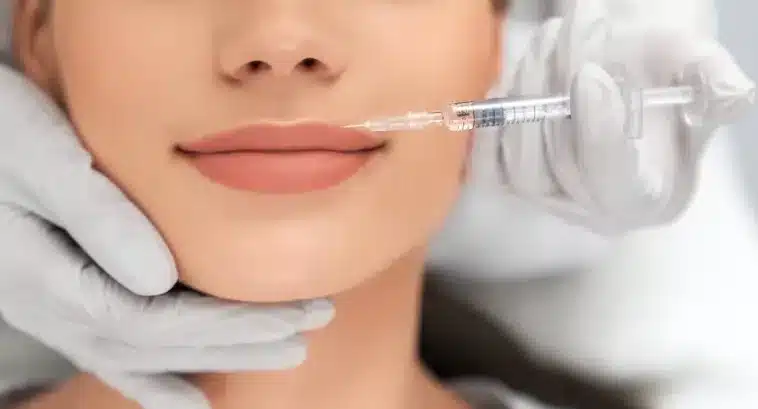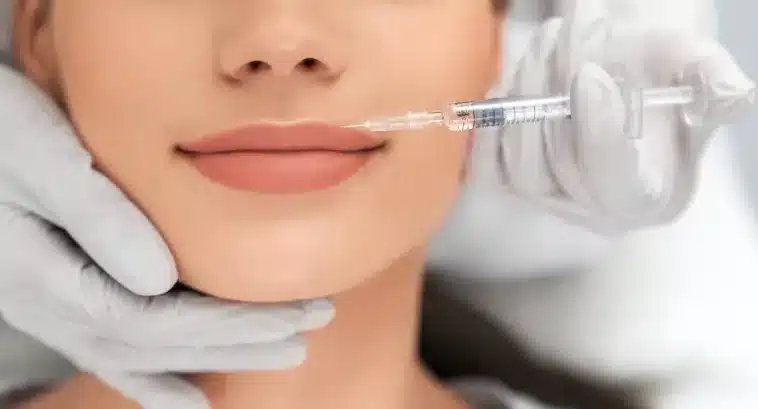Lip augmentation with Botox injections offers a transformative solution for addressing dynamic wrinkles and enhancing lip appearance. By targeting dynamic lip lines, Botox injections enable precise lip contouring, resulting in fuller and smoother lips with natural-looking results. This non-surgical procedure has gained popularity for its ability to rejuvenate the lips and restore a youthful, defined lip contour.
What is Lip Augmentation with Botox?
Lip augmentation with Botox is a non-surgical cosmetic procedure aimed at enhancing the fullness and shape of the lips. Unlike traditional lip fillers that use hyaluronic acid or other substances to increase lip volume, Botox relaxes the muscles around the mouth, giving the lips a plumper appearance.
What is Botox?
Botox is the brand name for botulinum toxin, a neurotoxic protein derived from the bacterium Clostridium botulinum. In cosmetic procedures, Botox is used to reduce the appearance of wrinkles and fine lines by temporarily paralyzing underlying muscles. The FDA has approved it for various cosmetic and medical treatments.
Clinic contact number: +989371200167
How Lip Augmentation with Botox Gets Done: Step by Step
- Consultation: The patient consults with a certified practitioner to discuss desired results and potential risks.
- Cleaning the Area: The lips and surrounding area are cleaned to prevent infection.
- Marking the Injection Points: The practitioner marks the areas where Botox will be injected.
- Applying Numbing Cream: A topical numbing cream is applied to reduce any discomfort during the procedure.
- Injecting Botox: The practitioner carefully injects Botox into the predetermined points using a fine needle.
- Massage: The lips may be gently massaged to distribute the Botox evenly.
- Post-Procedure Care: Patients are advised on aftercare, including avoiding certain activities and monitoring for adverse reactions.
Best Candidates for Lip Augmentation with Botox
Ideal candidates are adults who:
- Wish to achieve fuller lips without undergoing surgical procedures.
- Are in good health without contraindications to Botox.
- Have realistic expectations regarding the outcome.
Age Considerations for Lip Augmentation with Botox
While there’s no strict age restriction, most practitioners recommend lip augmentation for individuals aged 18 and above. It’s essential to consult with a certified professional to determine suitability based on individual needs.

10 Benefits of Lip Augmentation with Botox
- Non-Surgical Approach: Botox lip augmentation is a non-invasive procedure, eliminating the risks associated with surgeries like incisions, stitches, and scars.
- Quick and Simple: The procedure is usually completed within 20 to 30 minutes, making it convenient for busy people.
- Minimal Downtime: Most patients can return to their daily activities shortly after the treatment, although avoiding strenuous activity for 24 hours is recommended.
- Natural Appearance: Botox gives the lips a natural plumpness, avoiding the “overdone” look that some fillers might produce when administered correctly.
- Corrects “Gummy” Smile: Botox can be used to reduce the elevation of the upper lip, making fewer gums visible when smiling.
- Versatility: The procedure can be tailored to achieve various results, whether a patient wants a subtle change or a more noticeable enhancement.
- Temporary Results: For those uncertain about committing to permanent changes, Botox offers a temporary solution. Results typically last 3-4 months, allowing flexibility for future treatments.
- Lower Risk of Allergic Reaction: Botox is less likely to cause allergic reactions compared to some dermal fillers.
- Combine with Other Procedures: Botox can be combined with other cosmetic treatments for comprehensive facial rejuvenation.
- Confidence Boost: For many, achieving the desired lip fullness and shape can enhance self-esteem and confidence in their appearance.
A Botox lip flip can provide natural-looking lip augmentation by subtly enhancing the shape of your lips. Dr Saber
Clinic contact number: +989371200167
10 Risks of Lip Augmentation with Botox
- Bruising or swelling at the injection site.
- Asymmetry in the lips.
- Difficulty speaking, eating, or drinking.
- Over-relaxation of lip muscles.
- Adverse reactions to Botox.
- Unsatisfactory results.
- Potential for drooling.
- Migration of the product to other areas.
- Difficulty making certain facial expressions.
- Temporary numbness or tingling.
Clinic contact number: +989371200167
Lip Augmentation with Botox VS lip fillers
Botox and lip fillers have emerged as popular non-surgical options for enhancing lips. While they can both be used to augment the lips, they work in different ways and offer unique advantages and potential disadvantages. Let’s delve into a comparison of these two cosmetic procedures.
Lip cosmetic surgery has gained significant popularity in recent years as a way to enhance the appearance of the lips. From adding volume and definition to reshaping and rejuvenating the lips, various procedures are available to help individuals achieve their desired results. In this comprehensive guide, we will explore different types of lip cosmetic surgery.

Mechanism of Action
In summary, while Botox and lip fillers both offer effective options for lip augmentation, they work through different mechanisms: Botox relaxes muscles to reduce dynamic wrinkles, while lip fillers add volume and shape to the lips. The choice between Botox and lip fillers depends on the patient’s specific concerns, desired outcomes, and the recommendation of a qualified medical professional.
The mechanism of action differs between Botox and lip fillers in lip augmentation, reflecting their distinct properties and modes of action:
Botox
Botox is a neurotoxin that works by temporarily paralyzing muscles. Botox is administered around the mouth for lip augmentation, resulting in the relaxation of specific muscles. This can give the lips a subtle upward turn or reduce a “gummy” smile by reducing the elevation of the upper lip.
Lip Fillers
Lip fillers, such as those based on hyaluronic acid (like Juvéderm and Restylane), are injected directly into the lip tissue. They add volume to the lips by filling in the space beneath the skin.
Duration of Results
The duration of results for lip augmentation with Botox and lip fillers can vary depending on several factors, including the type of product used, individual metabolism, injection technique, and patient’s lifestyle habits. Here’s a general overview of the expected duration for each:
Botox
Results typically last between 3 to 4 months.
Lip Fillers
Depending on the type of filler used, results can last anywhere from 6 months to a year, and in some cases, even longer.

What Are the Different Types of Lip Augmentations?
Lip augmentation encompasses various techniques aimed at enhancing the size, shape, and appearance of the lips. One common type of lip augmentation involves the use of dermal fillers, such as hyaluronic acid-based products like Juvederm or Restylane. These fillers are injected into the lips to add volume, improve contour, and address asymmetry. The advantage of dermal fillers is their versatility, allowing for precise control over the amount of enhancement and the ability to tailor results to each patient’s aesthetic goals. Results from filler injections are typically temporary, lasting several months to a year, depending on the specific product used and individual factors.
Lip augmentation has become an increasingly popular cosmetic procedure in recent years as individuals seek to enhance their facial features and achieve a fuller, more youthful appearance.
This non-surgical or surgical procedure is designed to add volume, definition, and symmetry to the lips, resulting in a more aesthetically pleasing and confident look.
Another type of lip augmentation is lip implants, which involve surgically inserting synthetic implants into the lips to increase volume and definition. Lip implants come in various shapes and sizes and are typically made of silicone or other biocompatible materials. Unlike filler injections, lip implants offer a more permanent solution for lip enhancement, as they are not metabolized by the body. However, implant placement requires a surgical procedure and may involve a longer recovery period compared to filler injections. Additionally, the results of lip implants may not be as easily adjustable as those achieved with fillers.
Additionally, lip augmentation can be achieved through surgical techniques such as lip lift or lip advancement. A lip lift involves removing a small strip of skin from the area just above the upper lip, resulting in a more defined lip border and increased visibility of the vermilion (pink area) of the upper lip. This procedure can help reduce the distance between the nose and upper lip, creating a more youthful and balanced lip-to-nose ratio. Lip advancement, also known as vermilion advancement, involves surgically repositioning and reshaping the vermilion of the lips to increase their size and improve symmetry.

Insights from Leading Experts and Industry Trends
Lip augmentation with Botox, a procedure aimed at enhancing lip fullness and contour by targeting dynamic wrinkles, has garnered significant attention in recent years, with contributions from prominent figures such as Dr. Jean Carruthers and Dr. Alastair Carruthers from the University of British Columbia.
These pioneers in the field of cosmetic dermatology have played a pivotal role in advancing the understanding and application of Botox for aesthetic purposes, including lip augmentation. Their research and clinical expertise have contributed to the refinement of injection techniques and the establishment of safety and efficacy standards for Botox treatments. Among the most active companies in this field is Allergan, a pharmaceutical company known for developing Botox Cosmetic, the brand name for onabotulinumtoxinA.
Allergan has been at the forefront of innovation in cosmetic dermatology, continuously conducting research and clinical trials to expand the indications and improve the outcomes of Botox treatments. According to recent statistics from the American Society of Plastic Surgeons, Botox injections for lip augmentation have seen a steady rise in popularity, with over 2.3 million procedures performed in the United States alone in the past year. This surge in demand underscores the widespread acceptance and effectiveness of Botox as a non-surgical option for enhancing lip appearance and addressing dynamic wrinkles around the mouth.
Benefits of Hyaluronic Acid Fillers
Side Effects and Risks
While hyaluronic acid (HA) fillers are generally considered safe and well-tolerated, like any cosmetic procedure, they carry a risk of side effects and complications. Common side effects following HA filler injections may include temporary swelling, redness, bruising, and tenderness at the injection site. These side effects are usually mild to moderate in severity and typically resolve within a few days to a week after treatment. However, in some cases, more serious complications may occur, such as infection, allergic reactions, or vascular occlusion.
Infection is a rare but potential risk associated with HA filler injections. It can occur if bacteria enter the skin through the injection site, leading to inflammation and possible complications. To minimize the risk of infection, it’s essential to have HA filler injections performed by a qualified and experienced healthcare provider in a clean and sterile environment. Additionally, allergic reactions to HA fillers are uncommon but can occur in individuals with sensitivities to HA or other components of the filler formulation. Symptoms of an allergic reaction may include itching, swelling, hives, or difficulty breathing and should be promptly evaluated by a medical professional.
Another serious risk associated with HA fillers is vascular occlusion, where the filler inadvertently enters a blood vessel, leading to restricted blood flow to surrounding tissues. Vascular occlusion can cause tissue ischemia (lack of oxygen) and necrosis (tissue death), which require immediate medical attention to prevent long-term complications. Signs of vascular occlusion may include severe pain, blanching or pale discoloration of the skin, or the development of skin ulcers or nodules. Healthcare providers should be trained to recognize and manage vascular occlusion promptly to minimize the risk of permanent damage.
To mitigate the risks associated with HA fillers, patients should thoroughly discuss their medical history and any concerns with their healthcare provider before undergoing treatment. It’s essential to choose a qualified and experienced injector who follows proper injection techniques and maintains a sterile environment to minimize the risk of complications. Patients should also adhere to post-treatment instructions provided by their healthcare provider and seek prompt medical attention if they experience any concerning symptoms following HA filler injections. Overall, while side effects and risks are possible with HA fillers, they are generally rare and can be effectively managed with proper care and attention.
Summary
In conclusion, lip augmentation with Botox injections stands as a testament to the advancement of aesthetic enhancements in cosmetic dermatology. By specifically targeting dynamic wrinkles and dynamic lip lines, Botox injections offer a precise and effective method for achieving desired lip contouring and rejuvenation. The meticulous application of injection techniques, guided by rigorous safety standards, ensures not only optimal results but also peace of mind for patients seeking non-surgical solutions for lip enhancement.
As the field continues to evolve, ongoing research and innovation in Botox treatments promise to further refine and expand the possibilities of lip augmentation. With a commitment to safety, efficacy, and aesthetic excellence, lip augmentation with Botox injections remains a trusted option for individuals seeking to enhance their lip appearance and achieve natural-looking results without the need for invasive procedures.
Clinic contact number: +989371200167
FAQs
1. What is lip augmentation with Botox? Lip augmentation with Botox involves injecting botulinum toxin (Botox) into specific areas of the lips to enhance their appearance. Botox injections can relax muscles around the lips, resulting in a smoother lip surface, reduction of fine lines and wrinkles, and a subtle increase in lip volume.
2. What are the benefits of lip augmentation with Botox? One of the primary benefits of lip augmentation with Botox is its ability to provide natural-looking results with minimal downtime. Botox injections can smooth out wrinkles and fine lines around the lips, resulting in a more youthful and refreshed appearance. Additionally, Botox can create a subtle “lip flip” effect, where the upper lip curls slightly outward, giving the appearance of fuller lips.
3. Are there any risks associated with lip augmentation with Botox? While lip augmentation with Botox is generally considered safe, there are potential risks and side effects to be aware of. These may include temporary swelling, bruising, redness, or discomfort at the injection site. In rare cases, Botox injections can lead to asymmetry, drooping of the lips, or allergic reactions. It’s essential to have Botox injections performed by a qualified and experienced injector to minimize the risk of complications.
4. How long do the results of lip augmentation with Botox last? The results of lip augmentation with Botox typically last for about three to four months. Over time, the effects of Botox wear off, and muscle activity gradually returns to the treated area. To maintain the desired lip enhancement, patients may need to undergo periodic Botox injections.
5. Can lip augmentation with Botox be customized to achieve specific outcomes? Yes, lip augmentation with Botox can be customized to meet the individual needs and goals of each patient. The amount of Botox injected, as well as the injection technique and placement, can be tailored to achieve the desired lip volume and contour. Patients should discuss their aesthetic goals with their injector during the consultation to ensure a personalized treatment plan.
Cosmetic surgery crackdown now targeting fillers, botox and other procedures – ABC News
Can You Get Botox for Lip Enhancement? – Saber Plastic Surgery



